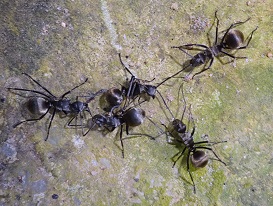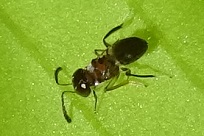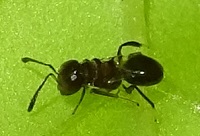| Home | Nature Weekly Index |
16 April 2017 | Ants in Singapore | Family: Formicidae |
 This week, I received an email from Ming Yang in Malaysia on my mislabelling of one ant as well as the identity
of another ant that I shared in my ant photo gallery. The one
mislabelled was Polyrhachis illaudata. It should instead be
Polyrhachis beccarii. I was told that Polyrhachis illaudata is found mainly as an arboreal ant while Polyrhachis beccarii is terrestrial. This
mid-size ant was relatively common in a nearby park and it was found mainly scavenging among the leaf litters.
More pictures of this ant is available in this
Ants and Termites blog
from Malaysia.
This week, I received an email from Ming Yang in Malaysia on my mislabelling of one ant as well as the identity
of another ant that I shared in my ant photo gallery. The one
mislabelled was Polyrhachis illaudata. It should instead be
Polyrhachis beccarii. I was told that Polyrhachis illaudata is found mainly as an arboreal ant while Polyrhachis beccarii is terrestrial. This
mid-size ant was relatively common in a nearby park and it was found mainly scavenging among the leaf litters.
More pictures of this ant is available in this
Ants and Termites blog
from Malaysia.
The one with the identity revealed was Camponotus parius. Although this ant looked very similar to Camponotus auriventris, it is of a smaller size. I had been looking high and low for a while on its identity and was grateful that someone had kindly shared this information.

 Recently, I had seen an unknown species of ant roaming around my potted plants. It normally operated alone and I
rarely seen more than two of them together. Also, it was highly elusive. Its tiny size, similar to that of the
Ghost Ant (Tapinoma melanocephalum),
made it even harder to spot them. Yesterday, while I was examining the weedy
Fringed Spiderflower (Cleome rutidosperma) in my pot,
I saw one of them at the back of a leaf and it was almost motionless. It was a rare opportunity to snap some
picture as this ant seemed to be always on the move. After magnifying the pictures, I started to wonder whether
it was really an ant or a wingless female wasp from the family Mutillidae, also known as Velvet Ant. So far, I
had only seen one member from this family,
Smicromyrme rufipes.
Recently, I had seen an unknown species of ant roaming around my potted plants. It normally operated alone and I
rarely seen more than two of them together. Also, it was highly elusive. Its tiny size, similar to that of the
Ghost Ant (Tapinoma melanocephalum),
made it even harder to spot them. Yesterday, while I was examining the weedy
Fringed Spiderflower (Cleome rutidosperma) in my pot,
I saw one of them at the back of a leaf and it was almost motionless. It was a rare opportunity to snap some
picture as this ant seemed to be always on the move. After magnifying the pictures, I started to wonder whether
it was really an ant or a wingless female wasp from the family Mutillidae, also known as Velvet Ant. So far, I
had only seen one member from this family,
Smicromyrme rufipes.
As far as pictorial guide of ants in Singapore is concern, it is still very much lacking when compared to other groups of insects such as butterflies or dragonflies. The information produced by expert such as Mark Wong was a bit too scientific for me and pictures shown in his website were mainly dead and dried specimen. Hopefully, the enthusiasm of ant-keeping community mentioned in my last week's post will be sustainable in the long run. Through that community's Facebook page, I got to know that some people were actually keeping our local fire ants Solenopsis geminata which I earlier thought had gone extinct since I had not seen it in the wild till January 2014. I had written about this now considered uncommon ant in my 2 previous posts, April 2016 and December 2016.